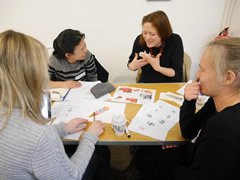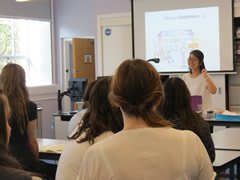2017 Japanese-Language Assistants’ Report: Japanese Language in a Multicultural and Multilingual Society: Initiatives in Primary and Secondary Education
The Japan Foundation, London
UKAI Kanako
In July 2016, one month after the UK's decision to leave the EU, I started my life as a Japanese-Language Assistant (hereafter referred to as "Assistant") at the Japan Foundation, London (hereafter referred to as "JFL"). JFL conducts Japanese-language courses, Japanese-language teacher training, speech contests, and exhibits at events, with the aim of promoting Japanese-language education in various parts of the UK and supporting a wide range of Japanese-language learning at various ages. Here, I would like to introduce the work that I am involved in.
Japanese for Primary Education

JTSMembers enjoying discussion at JTS training
In the UK, in 2002, the Department for Education and Skills (now the Department for Education) issued a language policy document titled "Languages for All: Languages for Life," which states that "by 2010, all children in Key Stage 2 (primary education years 3-6, ages 7-11) will have the opportunity to learn a foreign language." In 2014, foreign language education became compulsory, and Japanese also began to be taught in primary schools. Some schools were teaching Japanese, but JFL started the Japanese Taster for Schools (hereafter referred to as “JTS”) Programme with the goal of further promoting Japanese-language education. Initially, JFL's lecturers offered visiting Japanese-language courses in response to requests from schools that wanted to start Japanese-language classes or clubs but did not know how to go about it, but the number of schools requesting such classes continued to increase, so the JTS Programme was launched in 2006. It is an experiential course offered to primary and secondary schools that request it. Japanese-language volunteers introduce greetings, numbers, etc. to familiarize participants with Japanese culture. JTS started with 46 members and now has 390 members, which is a very heartening number of supporters. Currently, training sessions are held regularly to explain to new members what to be aware of at schools and how to create lessons, and to provide a place in which veteran members share with other members the activities they have carried out.
What surprised me here was the depth of the volunteer members. They have diverse backgrounds, and among the people I met at the training sessions there were a Japanese living in the UK, a British citizen who majored in Japanese studies at university and studied in Japan as an exchange student, an Indian who had worked in Japan for several years, and a Polish who had studied Japanese at university. I was also in charge of visiting lecture courses, where I had direct contact with the children and was able to meet the principals and teachers of the educational institutions I visited. I was able to hear first-hand about the current state of school education and foreign language education in the UK, and I hope to use the great amount of information I received in my current efforts to develop teaching materials for primary education.
New Form of Japanese-Language Education
The Japan Foundation subsidizes a portion of the expenses for Japanese-language promotion activities by various organizations and groups, and JFL is implementing the Japanese Language Local Project Support Programme. This program provides grants focused on primary and secondary schools that offer Japanese-language classes and secondary schools that offer exam preparation classes, such as for the General Certificate of Secondary Education. I would like to introduce a secondary school that started Japanese-language classes using this system.

A scene from a visiting Japanese-language class held in Scotland
Students aged 4-19 with autism and learning disabilities attend a Special Needs Education School in the City of London where one class started learning Japanese through origami, animation, math and karate this year. On the day I visited the school, after watching a video of the Japanese class activities with all the students at the school assembly, I visited the class where the students were studying Japanese and was greeted by the students saying, "Ohayo!" In addition, I was able to directly ask the teacher in charge of the classes about their methods and the challenges in teaching Japanese in special needs education. I was particularly impressed by the words of the teacher who organized this class in order to start Japanese-language education. "For many students, their world now consists only of school and home. There are many different types of disabilities, and there are still many problems that prevent disabled persons from going abroad and experiencing different cultures. That's why I decided to bring a different culture, Japanese culture, to the school." Through Japanese-language education in special needs education I was able to see Japanese-language education from a new perspective, not as a compulsory subject, but as a subject like art or music that fosters humanity, and I felt new possibilities for Japanese-language education.
JFL is engaged in a wide range of Japanese language related programs, and the Assistant works as part of a team, receiving advice and cooperation from Japanese-Language Senior Specialists and Japanese-Language Specialists as well as the local staff and personnel. In addition, I am grateful for the blessed environment of being able to participate in various conferences and workshops in the UK, a country where research on foreign language education is flourishing, and I would like to diligently tackle each task in front of me so that I can grow as a Japanese-language teacher.
- What We Do Top
- Arts and Cultural Exchange [Culture]
- Japanese-Language Education Overseas [Language]
- Japanese-Language Education Overseas [Language] Top
- Learn Japanese-language
- Teach Japanese-language
- Take Japanese-Language Test
- Know about Japanese-language education abroad
- The Japanese-Language Institute, Urawa
- The Japanese-Language Institute, Kansai
- Japanese-Language Programs for Foreign Specified Skilled Worker Candidates
- Japanese Language Education for Japanese Children Resident Overseas and for the Descendants of Migrants
- Archives
- Japanese Studies and Global Partnerships [Dialogue]
- JF digital collection
- Other Programs / Programs to Commemorate Exchange Year
- Awards and Prizes
- Publications
